We’re pleased to announce that Pain Physicians of Wisconsin is now Pro Spine Pain.
We’re pleased to announce that Pain Physicians of Wisconsin is now Pro Spine Pain.
Minimally invasive lumbar fusion is performed to stabilize the vertebral bones and spinal joints. It is a procedure that treats back and leg pain caused by spinal instability.
We consider the minimally invasive lumbar fusion procedure when conservative treatments like medications, physical therapy, and other pain management treatments like epidural steroid injections and radiofrequency ablation fail to provide adequate relief. If you are experiencing chronic low back pain and leg pain due to spinal instability, you do not have to tolerate it any longer.
Unlike open or traditional surgery, minimally invasive lumbar fusion requires one or more small (half-inch) incisions through the skin. The procedure causes less damage to your muscles and requires less recovery time. The considerable advantage is that you can go home the same day and your recovery period is usually about a week.
Minimally invasive lumbar fusion is an option for patients suffering from chronic back and leg pain along with one, or more, of the following diagnoses:
When there are anatomic changes and a loss of function of varying degrees of one or more intervertebral discs
When the spinal column narrows and extends pressure on the spinal cord and nerves
When two backbones shift, which may pinch a spinal nerve to cause leg pain
When inflammation of a nerve root in the lower back causes symptoms of pain or irritation in the back and down the legs.
The procedure is done through a minimally invasive incision along the back, where the physician will gently move tissue and muscle to access the spine. After completing site preparation, the doctor places an interspinous spacer on the spine and affixes the two sides of the implant together for a full closure. This reinforcement of the spine is known as a fusion.
 There are various types of lumbar spinal fusion surgery. They differ slightly based on the location in your spine and where the pain is coming from. After receiving the results of diagnostic imaging scans and identifying the affected area, you’ll be referred for either lumbar spinal fusion or lateral, posterior, or transforaminal fusion.
There are various types of lumbar spinal fusion surgery. They differ slightly based on the location in your spine and where the pain is coming from. After receiving the results of diagnostic imaging scans and identifying the affected area, you’ll be referred for either lumbar spinal fusion or lateral, posterior, or transforaminal fusion.
Here are the main differences between these procedures:
To ensure an efficient postoperative healing process, our advanced practice providers will regularly contact you to review your progress. Around 14 days after your operation date, you’ll be scheduled for a postoperative review.
After having the lumbar spinal fusion surgery, you’re likely to be advised to:
Call us immediately if you experience any of the following:
Making a full recovery following a lumbar spinal fusion can often take several months, based on your surgery, age, and lifestyle. Your surgeon may refer you for physical therapy to increase your strength, mobility, and range of motion to ensure your spine aligns properly.
Just like any spinal surgery, a lumbar fusion can have some associated risks. The risks can occur due to various factors, such as the type of spinal fusion performed and your health.
The following risks could occur:
At Pro Spine & Pain, we know the potential risks a lumbar fusion could create. However, by abiding to strict clinical protocols, using a collaborative approach, using state-of-the-art diagnostic imaging and advanced surgical techniques, we have one of the lowest complication rates for lumbar fusions in Wisconsin.
The procedure is performed just once. However, an additional implant can be added at a different spine level in future, if needed.
Patients should avoid twisting and bending after the procedure. You should also require you to prevent pushing, lifting or pulling objects greater than 5lbs until you are through your recovery period.
After around 8-12 months following your spinal fusion surgery, you can expect to return to a normal life. However, to return to your normal routine, you must strictly abide by your doctor’s instructions for a smoother, successful outcome.
On average, it can take one year to recover from lumbar surgery. Initially, you may find it difficult to sit or stand in one position for a prolonged period. After that, it might take 4-6 weeks to begin doing simple activities, like housework. During your recovery, you might be advised to wear a back brace to ensure effective healing.
Often, the fastest way to recover from a spinal fusion is by maintaining a healthy diet, taking pain relief, resting properly, attending physical therapy appointments, and following the orders of your doctor.